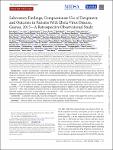Laboratory Findings, Compassionate Use of Favipiravir, and Outcome in Patients With Ebola Virus Disease, Guinea, 2015—A Retrospective Observational Study
Kerber, Romy
Lorenz, Eva
Duraffour, Sophie
Sissoko, Daouda
Rudolf, Martin
Jaeger, Anna
Ditinn Cisse, Sekou
Camara, Alseny-Modet
Miranda, Osvaldo
Castro, Carlos M.
Akoi Bore, Joseph
Kundouno, Fara Raymond
Repits, Johanna
Afrough, Babak
Becker-Ziaja, Beate
Hinzmann, Julia
Mertens, Marc
Vitoriano, Ines
Logue, Christopher Hugh
Böttcher, Jan-Peter
Pallasch, Elisa
Sachse, Andreas
Bah, Amadou
Cabeza-Cabrerizo, Mar
Nitzsche, Katja
Kuisma, Eeva
Michel, Janine
Holm, Tobias
Zekeng, Elsa Gayle
Cowley, Lauren A.
Garcia-Dorival, Isabel
Hetzelt, Nicole
Baum, Jonathan Hans Josef
Portmann, Jasmine
Carter, Lisa
Yenamaberhan, Rahel Lemma
Camino, Alvaro
Enkirch, Theresa
Singethan, Katrin
Meisel, Sarah
Mazzarelli, Antonio
Kosgei, Abigail
Kafetzopoulou, Liana
Rickett, Natasha Y.
Patrono, Livia Victoria
Ghebreghiorghis, Luam
Arnold, Ulrike
Colin, Géraldine
Juchet, Sylvain
Marchal, Claire Levy
Kolie, Jacques Seraphin
Beavogui, Abdoul Habib
Wurr, Stephanie
Bockholt, Sabrina
Krumkamp, Ralf
May, Jürgen
Stoecker, Kilian
Fleischmann, Erna
Ippolito, Giuseppe
Carroll, Miles W.
Koivogui, Lamine
Magassouba, N’Faly
Keita, Sakoba
Gurry, Céline
Drury, Patrick
Diallo, Boubacar
Formenty, Pierre
Wölfel, Roman
Di Caro, Antonino
Gabriel, Martin
Anglaret, Xavier
Malvy, Denis
Günther, Stephan
Background
In 2015, the laboratory at the Ebola treatment center in Coyah, Guinea, confirmed Ebola virus disease (EVD) in 286 patients. The cycle threshold (Ct) of an Ebola virus–specific reverse transcription–polymerase chain reaction assay and 13 blood chemistry parameters were measured on admission and during hospitalization. Favipiravir treatment was offered to patients with EVD on a compassionate-use basis.
Methods
To reduce biases in the raw field data, we carefully selected 163 of 286 patients with EVD for a retrospective study to assess associations between potential risk factors, alterations in blood chemistry findings, favipiravir treatment, and outcome.
Results
The case-fatality rate in favipiravir-treated patients was lower than in untreated patients (42.5% [31 of 73] vs 57.8% [52 of 90]; P = .053 by univariate analysis). In multivariate regression analysis, a higher Ct and a younger age were associated with survival (P < .001), while favipiravir treatment showed no statistically significant effect (P = .11). However, Kaplan-Meier analysis indicated a longer survival time in the favipiravir-treated group (P = .015). The study also showed characteristic changes in blood chemistry findings in patients who died, compared with survivors.
Conclusions
Consistent with the JIKI trial, this retrospective study revealed a trend toward improved survival in favipiravir- treated patients; however, the effect of treatment was not statistically significant, except for its influence on survival time.
Dateien zu dieser Publikation

